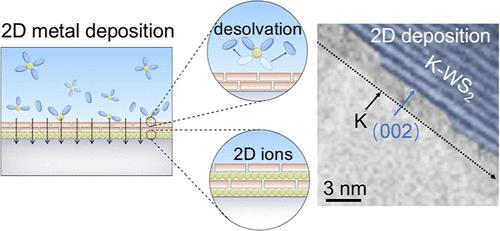Dendrite-Free High-Capacity Alkali Metal Batteries by Two-Dimensional Confinement of Desolvated Ions
IF 15.6
1区 化学
Q1 CHEMISTRY, MULTIDISCIPLINARY
引用次数: 0
Abstract
Alkali metal anodes (Li, Na, and K) hold great promise for energy storage due to their high specific capacities and low reduction potentials. However, the deposition of alkali metals is frequently disrupted by a simultaneous desolvation process, leading to dendrite growth and rapid capacity decay. In this work, we present a general strategy to achieve dendrite-free, high-capacity alkali metal batteries by utilizing the two-dimensional (2D) confinement of desolvated ions. 2D transition metal disulfides (TMDSs) are employed as interlayers with high adsorption energy for alkali metal ions, effectively facilitating the rapid separation of the desolvation process from metal deposition. The desolvated ions, characterized by high diffusivity, are confined within the 2D channels of TMDSs, enabling planar alkali metal deposition without interference from the desolvation process. Furthermore, the TMDS interlayers avoid side reactions between solvents and metals during deposition, resulting in a thin solid electrolyte interphase that promotes fast ion diffusion. This approach enables dendrite-free K metal batteries capable of plating/stripping at 10 mAh cm–2 and cycling at 36 C for over 3000 cycles. Our strategy provides a novel pathway to advance high-energy metal batteries, significantly enhancing their performance and longevity.

无枝晶大容量碱金属电池的二维失溶离子约束
碱金属阳极(Li, Na和K)由于其高比容量和低还原电位而在储能方面具有很大的前景。然而,碱金属的沉积经常被同时发生的脱溶过程打断,导致枝晶生长和容量迅速衰减。在这项工作中,我们提出了一种利用二维(2D)脱离子约束来实现无枝晶、高容量碱金属电池的一般策略。利用二维过渡金属二硫化物(tmds)作为对碱金属离子具有高吸附能的中间层,有效地促进了脱溶过程与金属沉积的快速分离。具有高扩散率的脱溶离子被限制在TMDSs的二维通道内,使平面碱金属沉积不受脱溶过程的干扰。此外,TMDS夹层在沉积过程中避免了溶剂和金属之间的副反应,形成了薄的固体电解质界面,促进了离子的快速扩散。这种方法使无枝晶K金属电池能够在10mah cm-2下电镀/剥离,并在36℃下循环超过3000次。我们的策略为推进高能金属电池提供了一条新途径,显著提高了它们的性能和寿命。
本文章由计算机程序翻译,如有差异,请以英文原文为准。
求助全文
约1分钟内获得全文
求助全文
来源期刊
CiteScore
24.40
自引率
6.00%
发文量
2398
审稿时长
1.6 months
期刊介绍:
The flagship journal of the American Chemical Society, known as the Journal of the American Chemical Society (JACS), has been a prestigious publication since its establishment in 1879. It holds a preeminent position in the field of chemistry and related interdisciplinary sciences. JACS is committed to disseminating cutting-edge research papers, covering a wide range of topics, and encompasses approximately 19,000 pages of Articles, Communications, and Perspectives annually. With a weekly publication frequency, JACS plays a vital role in advancing the field of chemistry by providing essential research.

 求助内容:
求助内容: 应助结果提醒方式:
应助结果提醒方式:


